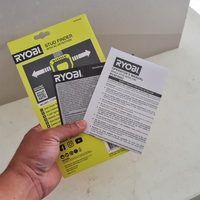- Subscribe to RSS Feed
- Mark as New
- Mark as Read
- Bookmark
- Subscribe
- Printer Friendly Page
- Report Inappropriate Content
Difficulty: Beginner
A stud finder can help you safely locate studs behind walls for hanging pictures, shelves or other items.
Studs are wooden or metal vertical frames hidden in walls that can be used as points to hang or support items. A stud finder detects studs inside a wall using a magnetic field and notifies you when there is a change in the field.
Here is a simple guide on how to use a stud finder correctly, including tips on avoiding inaccurate readings.
Once you have found your studs, refer to our guide How to hang just about anything for more advice. Let us know if you have any questions.
Steps
Step 1
1/5Get to know your stud finder.
Read your stud finder’s instruction manual for specific instructions about its features and how it works. Pay particular attention to the calibration process (if required), as improper calibration is a common reason for inaccurate readings.
Ensure your stud finder has fresh batteries and is adequately charged before use. Weak batteries can also lead to unreliable results.
I am using a Ryobi stud finder which detects metal, timber and live electrical wires.


Step 2
2/5Prepare your wall.
Remove any furniture, artwork, or decorations that may obstruct your wall's surface and prevent the stud finder from working optimally.
Turn off and unplug any electrical devices near the wall to avoid interference.

Step 3
3/5Calibrate your stud finder if needed.
If your device has multiple scanning modes, ensure it is set on stud mode.
Some stud finders may also require calibration before use, which involves fine-tuning the device according to your wall type for more accurate readings.
To calibrate a stud finder, grip it securely, keeping sensors and buttons clear. Now hold it level and parallel to a plain section of the wall for a baseline signal and press or hold the calibration button. Wait for the device to notify you it has finished calibrating. Refer to your product manual for more specific instructions.
Once your stud finder is ready for use, place it on the wall away from any light switches, plumbing fittings or power points.
Step 4
4/5Scan the wall.
Place the stud finder against the wall at a straight angle, ensuring it is level with the surface.
Slide the stud finder in a horizontal direction. Maintain a slow steady pace.
Most stud finders have LED lights or audio indicators that will signal you are near a stud. Some units also provide more precise information, including whether you are near the edge or the middle of a stud.
Studs are typically detected every 450mm or so in most walls, running vertically from the ceiling to the floor. Certain factors like textured walls, wallpaper, or layers of paint may interfere with the stud finder's accuracy. Double-check readings if you encounter inconsistent signals.


Step 5
5/5Mark the studs.
Once the stud finder detects a stud, mark the centre point using a pencil.
To ensure accuracy, scan the marked area again to confirm the stud's location.
Continue scanning in adjacent areas if you need to locate multiple studs.
You have now successfully located studs in your wall and can proceed to hang or mount items safely.



Materials
Tools
- Batteries.
- Stud finder, like Ryobi Stud Finder with AC Detection RYSF5003
- Pencil.
Images












You must be a registered Workshop community member to comment. Please join Workshop or sign in to join in the discussion.
Why join the Bunnings Workshop community?
Workshop is a friendly place to learn, get ideas and find inspiration for your home improvement projects
| Subject | Author | Posted | |
|---|---|---|---|
| October 2022 | |||
| February | |||
| September | |||
| December | |||
| June 2021 |








